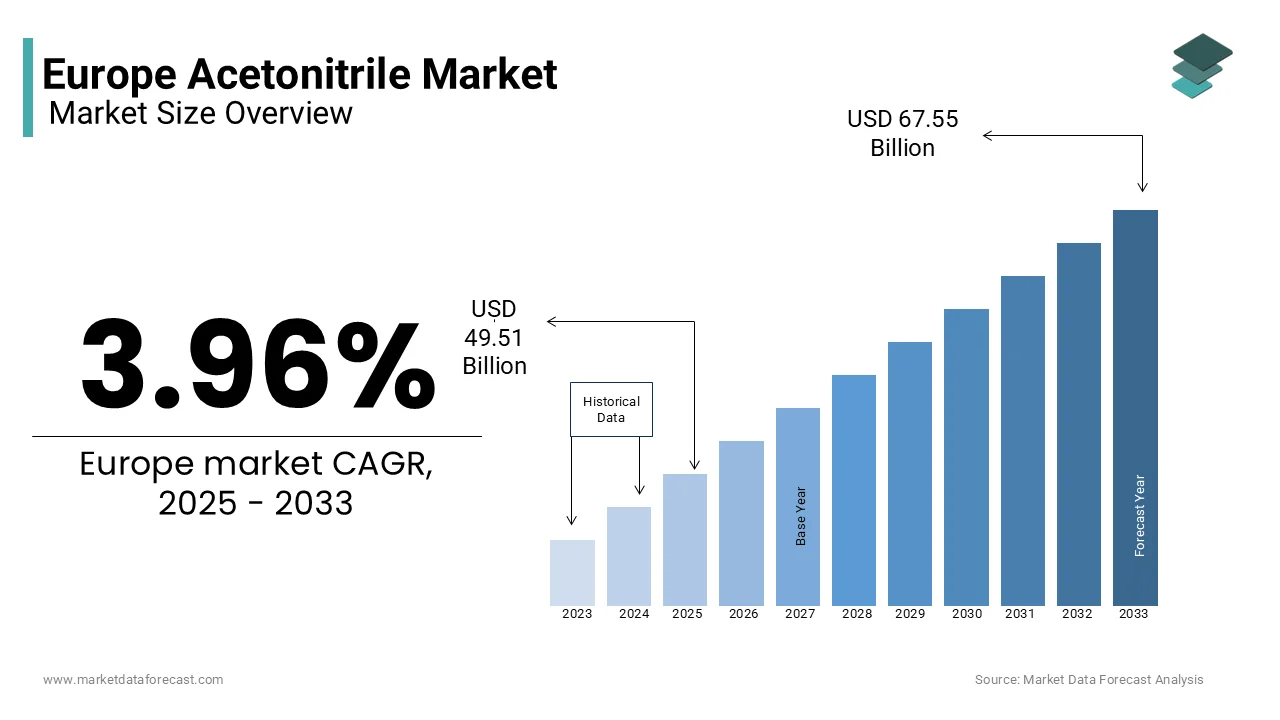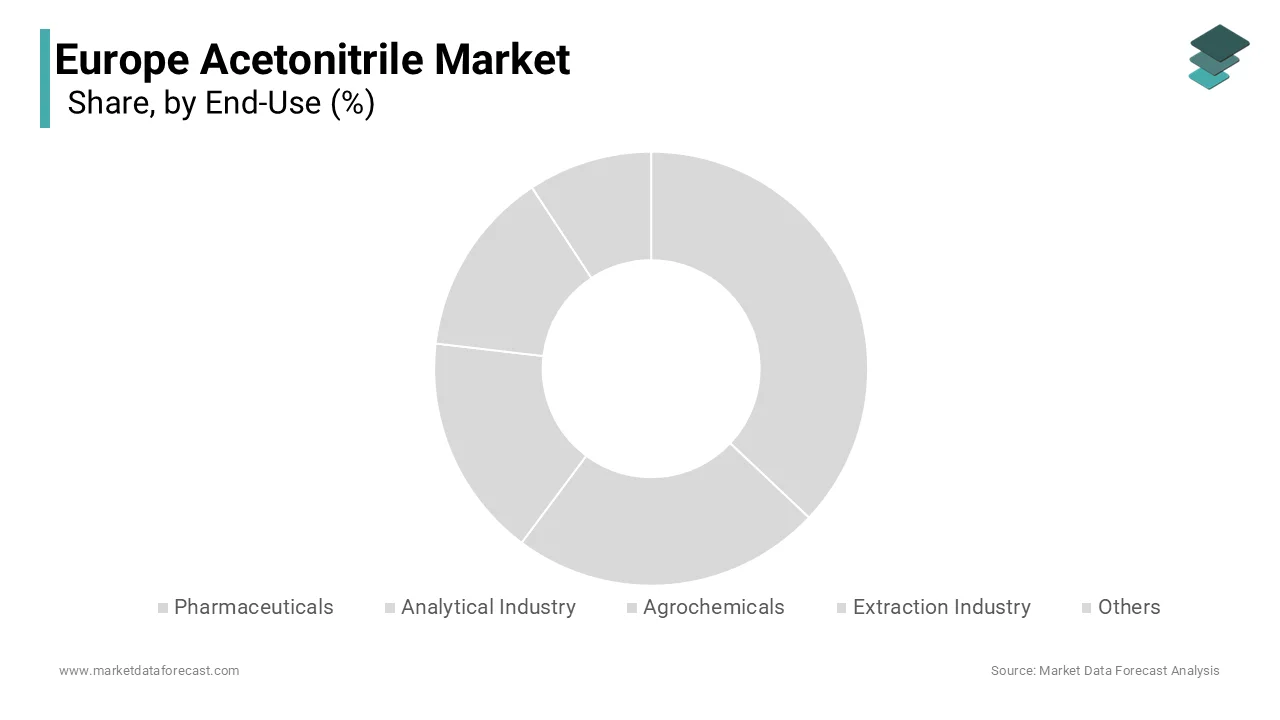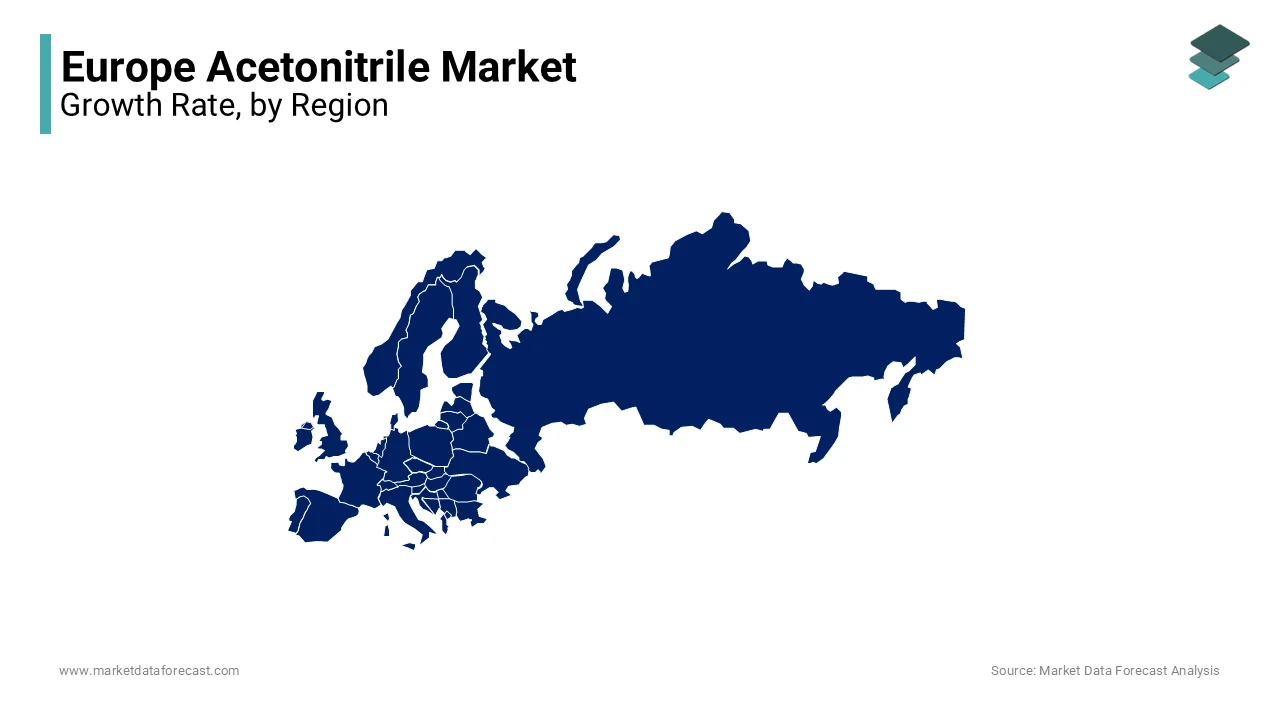Europe Acetonitrile Market Size, Share, Trends & Growth Forecast Report By End-Use (Pharmaceuticals, Analytical Industry, Agrochemicals, Extraction Industry, and Others), and Country (UK, France, Spain, Germany, Italy, Russia, Sweden, Denmark, Switzerland, Netherlands, Turkey, Czech Republic & Rest of Europe), Industry Analysis From 2025 to 2033
Europe Acetonitrile Market Size
The Europe acetonitrile market size was valued at USD 47.62 billion in 2024. The European market is estimated to be worth USD 67.55 billion by 2033 from USD 49.51 billion in 2025, growing at a CAGR of 3.96% from 2025 to 2033.

Acetonitrile is primarily used as a solvent in various applications, including pharmaceuticals, analytical chemistry, and the extraction of natural products. Its unique properties, such as high polarity and low viscosity, make it an ideal solvent for a wide range of chemical reactions and processes. The acetonitrile market in Europe is experiencing significant growth due to the increasing demand for acetonitrile in the pharmaceutical sector, where it is utilized in the synthesis of active pharmaceutical ingredients (APIs) and as a solvent in high-performance liquid chromatography (HPLC). Over the forecast period, the advancements in production technologies and the development of innovative applications for acetonitrile are likely to fuel the demand for acetonitrile in the European region. As industries continue to prioritize efficiency and sustainability, the acetonitrile market is poised for substantial expansion, driven by the ongoing demand for high-quality chemical solutions.
MARKET DRIVERS
Increasing Demand from the Pharmaceutical Industry
The increasing demand from the pharmaceutical industry is a significant driver of the Europe acetonitrile market. Acetonitrile is widely used in the synthesis of active pharmaceutical ingredients (APIs) and as a solvent in various pharmaceutical processes, including high-performance liquid chromatography (HPLC). According to the European Federation of Pharmaceutical Industries and Associations, the pharmaceutical market in Europe is projected to reach €300 billion by 2025, reflecting a steady growth trajectory. This growth in the pharmaceutical sector is driving the demand for acetonitrile, as manufacturers seek to develop innovative and effective drug formulations. Furthermore, the emphasis on research and development in the pharmaceutical industry is leading to an increased need for high-quality solvents like acetonitrile, which are essential for ensuring the purity and efficacy of pharmaceutical products. As the pharmaceutical industry continues to expand and innovate, the demand for acetonitrile is expected to grow significantly, reinforcing its importance in the overall market.
Growth in Analytical Chemistry Applications
The growth in analytical chemistry applications is further boosting the growth of the Europe acetonitrile market. Acetonitrile is a preferred solvent in various analytical techniques, including HPLC, gas chromatography, and mass spectrometry, due to its excellent solvent properties and ability to dissolve a wide range of compounds. The increasing focus on quality control and assurance in laboratories, coupled with the rising demand for accurate analytical results, is propelling the growth of this segment. The demand for analytical chemistry is growing steadily worldwide, which is further boosting the demand for acetonitrile as a key solvent in these applications. The importance of this segment lies in its ability to provide reliable and reproducible results in analytical testing, which is critical for various industries, including pharmaceuticals, food and beverage, and environmental monitoring. As the demand for analytical services continues to rise, the acetonitrile market is well-positioned to benefit from this growth, ensuring its relevance in the chemical industry.
MARKET RESTRAINTS
Regulatory Challenges and Compliance Issues
Regulatory challenges and compliance issues is a significant restraint on the Europe acetonitrile market. The production and use of acetonitrile are subject to stringent regulations regarding environmental and health safety standards. The European Union's REACH (Registration, Evaluation, Authorisation and Restriction of Chemicals) regulation imposes rigorous requirements on the registration and assessment of chemical substances, which can complicate the formulation and approval processes for new products. According to industry estimates, approximately 30% of chemical manufacturers face delays in product approvals due to regulatory hurdles, impacting their ability to bring innovative acetonitrile products to market. Additionally, the evolving regulatory landscape, including potential changes in safety standards and restrictions on certain substances, adds further complexity for manufacturers. As companies navigate these regulatory challenges, the potential for increased operational costs and delays in product launches may hinder growth in the acetonitrile market.
Market Volatility and Price Fluctuations
Market volatility and price fluctuations pose significant challenges for the Europe acetonitrile market. The prices of raw materials used in the production of acetonitrile, such as propylene and ammonia, are influenced by various factors, including geopolitical tensions, supply chain disruptions, and changes in global demand. The price of acetonitrile has experienced fluctuations of up to 15% over the past two years due to these factors. This volatility can create uncertainty for manufacturers, making it difficult to budget and plan production effectively. Additionally, rising costs of energy and transportation can further exacerbate price fluctuations, impacting the overall profitability of acetonitrile producers. As the market grapples with these challenges, stakeholders must develop strategies to mitigate risks associated with price volatility, such as long-term contracts and diversified sourcing strategies, to ensure stability and sustainability in their operations.
MARKET OPPORTUNITIES
Expansion of the Biopharmaceutical Sector
The expansion of the biopharmaceutical sector is a significant opportunity for the Europe acetonitrile market. As the biopharmaceutical industry continues to grow, driven by advancements in biotechnology and an increasing focus on personalized medicine, the demand for high-quality solvents like acetonitrile is expected to rise. Acetonitrile is widely used in the purification and analysis of biopharmaceutical products, including monoclonal antibodies and recombinant proteins. According to the European Biopharmaceutical Enterprises, the biopharmaceutical market in Europe is projected to reach €100 billion by 2025, reflecting a robust growth trajectory. This growth is driving the need for effective solvents that ensure the purity and efficacy of biopharmaceutical products. As manufacturers invest in research and development to create innovative biopharmaceutical formulations, the acetonitrile market is well-positioned to capitalize on this growth. The emphasis on quality and efficiency in the biopharmaceutical sector will continue to drive demand for acetonitrile, creating lucrative opportunities for manufacturers in this evolving market.
Technological Advancements in Production Processes
Technological advancements in production processes offer another promising opportunity for the Europe acetonitrile market. Innovations in manufacturing technologies, such as improved catalytic processes and more efficient separation techniques, are enabling producers to enhance the yield and quality of acetonitrile while reducing production costs. According to industry forecasts, the implementation of advanced production technologies can lead to efficiency gains of up to 20% in acetonitrile manufacturing. Furthermore, the integration of digital technologies and automation in production facilities is streamlining operations and improving overall productivity. As companies continue to invest in technology to optimize their production processes, the acetonitrile market is poised for significant growth. Embracing these technological advancements not only enhances competitiveness but also aligns with the industry's broader goals of sustainability and efficiency.
MARKET CHALLENGES
Supply Chain Disruptions
Supply chain disruptions have emerged as a significant challenge for the Europe acetonitrile market, particularly in the wake of the COVID-19 pandemic. The pandemic has exposed vulnerabilities in global supply chains, leading to delays in the delivery of essential raw materials and increased costs. According to a survey conducted by the European Chemical Industry Council, approximately 65% of chemical manufacturers reported experiencing supply chain issues in 2021, with many citing difficulties in sourcing key materials for acetonitrile production. These disruptions can hinder production schedules, increase operational costs, and ultimately impact the overall growth of the acetonitrile market. Furthermore, geopolitical tensions and trade restrictions can exacerbate supply chain challenges, leading to further uncertainty in the availability of essential materials. As the industry grapples with these supply chain issues, stakeholders must develop strategies to mitigate risks and ensure a stable supply of materials to support ongoing and future projects.
Consumer Awareness and Education
Consumer awareness and education present a challenge for the Europe acetonitrile market. As consumers become more informed about chemical products and their potential impacts on health and the environment, there is an increasing demand for transparency regarding the ingredients used in various applications. According to a survey by the European Consumer Organisation, approximately 70% of consumers express concern about the chemicals used in everyday products, including those derived from acetonitrile. This heightened scrutiny can lead to skepticism regarding the safety and efficacy of certain acetonitrile applications, particularly those that are synthetic. As a result, manufacturers must invest in consumer education and transparency initiatives to build trust and demonstrate the safety and benefits of their products. Additionally, the growing trend towards natural and organic products may further challenge the acceptance of certain acetonitrile applications, necessitating a shift towards more sustainable formulations. As the market navigates these challenges, companies must prioritize consumer education and transparency to ensure the continued growth and acceptance of acetonitrile.
REPORT COVERAGE
|
REPORT METRIC |
DETAILS |
|
Market Size Available |
2024 to 2033 |
|
Base Year |
2024 |
|
Forecast Period |
2025 to 2033 |
|
CAGR |
3.96% |
|
Segments Covered |
By End-Use, and Region |
|
Various Analyses Covered |
Global, Regional, & Country Level Analysis; Segment-Level Analysis; DROC; PESTLE Analysis; Porter’s Five Forces Analysis; Competitive Landscape; Analyst Overview of Investment Opportunities |
|
Regions Covered |
UK, France, Spain, Germany, Italy, Russia, Sweden, Denmark, Switzerland, Netherlands, Turkey, Czech Republic, Rest of Europe |
|
Market Leaders Profiled |
Honeywell International, Inc., Thermo Fisher Scientific, Inc., INEOS Group Holdings S.A, Asahi Kasei Corporation, PetroChina Company Limited (China National Petroleum Corporation), Formosa Plastics Group, Avantor, Inc., Nantong Acetic Acid Chemical Co., Ltd., Neuchem Inc., and Nova Molecular Technologies, Inc, and others. |
SEGMENTAL ANALYSIS
By End-Use
The pharmaceuticals segment accounted for 40.4% of the European market share in 2024. Acetonitrile is extensively utilized in the pharmaceutical industry as a solvent for the synthesis of active pharmaceutical ingredients (APIs) and in high-performance liquid chromatography (HPLC) for drug analysis. The increasing demand for high-quality pharmaceuticals, driven by an aging population and rising healthcare needs, is propelling the growth of this segment. According to the European Federation of Pharmaceutical Industries and Associations, the pharmaceutical market in Europe is projected to reach €300 billion by 2025, reflecting a steady growth trajectory. This growth in the pharmaceutical sector is driving the demand for acetonitrile, as manufacturers seek to develop innovative and effective drug formulations. The importance of this segment lies in its ability to provide reliable and efficient solutions for pharmaceutical applications, ensuring the safety and efficacy of drug products. As the pharmaceutical industry continues to expand and innovate, the demand for acetonitrile is expected to grow significantly, reinforcing its importance in the overall market.

The analytical segment is projected to achieve a CAGR of 6.12% over the forecast period. Acetonitrile is a preferred solvent in various analytical techniques, including HPLC, gas chromatography, and mass spectrometry, due to its excellent solvent properties and ability to dissolve a wide range of compounds. The increasing focus on quality control and assurance in laboratories, coupled with the rising demand for accurate analytical results, is propelling the growth of this segment.
REGIONAL ANALYSIS
Germany stands as the leading country in the Europe acetonitrile market by accounting for 26.6% of the regional market share in 2024. The robust chemical industry in Germany, particularly in pharmaceuticals and analytical applications, significantly contributes to this dominance. According to the German Chemical Industry Association, the production of acetonitrile in Germany reached over 50,000 tons in 2021, underscoring the critical role of this solvent in various applications. The country’s strong focus on research and development, coupled with its advanced manufacturing capabilities, positions it as a key player in the acetonitrile market. Additionally, Germany's commitment to sustainability and innovation is driving the adoption of high-quality acetonitrile that meets the evolving needs of industries. The increasing demand for pharmaceuticals and analytical services in Germany is further propelling the growth of this market. As the demand for high-quality acetonitrile continues to rise, Germany's position as a market leader is expected to remain strong, reinforcing its influence in the European acetonitrile market.

France was the second-largest market for acetonitrile in Europe in 2024. The French chemical industry is characterized by significant investments in pharmaceuticals and analytical applications, driven by the growing demand for high-quality products. According to the French Ministry of Economy and Finance, the production of acetonitrile in France reached around 30,000 tons in 2021, reflecting a robust market for this solvent. The emphasis on improving product performance and sustainability is driving French manufacturers to adopt advanced acetonitrile formulations that meet regulatory requirements and consumer expectations. Furthermore, France's focus on innovation and research in the chemical sector is influencing the development of specialized acetonitrile applications. As the French market continues to evolve, the demand for acetonitrile is expected to grow, reinforcing France's position as a key player in the European market.
Italy is another notable player in the Europe acetonitrile market. The Italian chemical industry is diverse, with significant production in pharmaceuticals, agrochemicals, and analytical applications. According to the Italian National Institute of Statistics, the production of acetonitrile in Italy reached over 20,000 tons in 2021, highlighting the importance of this solvent in various applications. The increasing focus on high-quality materials and sustainable practices is driving the demand for acetonitrile in Italy. Additionally, Italy's strategic location within Europe facilitates trade and distribution, further enhancing its position in the acetonitrile market. As the country continues to invest in modernization and innovation, the demand for acetonitrile is expected to rise, contributing to the overall growth of the market.
The United Kingdom is another significant player in the Europe acetonitrile market. The UK chemical industry is characterized by a diverse range of applications, including pharmaceuticals, analytical chemistry, and agrochemicals. According to the UK Chemical Industries Association, the production of acetonitrile in the UK reached around 15,000 tons in 2021, reflecting a strong demand for this solvent. The emphasis on improving product performance and sustainability is driving UK manufacturers to invest in high-quality acetonitrile that meets regulatory requirements. Furthermore, the UK's commitment to innovation and research in the chemical sector is influencing the development of advanced acetonitrile formulations. As the UK navigates post-Brexit challenges, the acetonitrile market is expected to adapt and evolve, presenting opportunities for growth.
Spain is predicted to witness a healthy CAGR in the European acetonitrile market over the forecast period. The Spanish chemical industry is experiencing significant growth, driven by a resurgence in pharmaceuticals and analytical applications. According to the Spanish Ministry of Industry, Trade and Tourism, the production of acetonitrile in Spain reached over 10,000 tons in 2021, highlighting the importance of this solvent in various applications. The increasing focus on sustainable practices and the demand for high-quality products are propelling the growth of the acetonitrile market in Spain. Additionally, Spain's growing e-commerce sector is driving the need for innovative chemical solutions that enhance product performance. As the country continues to develop its industrial capabilities and invest in sustainable practices, the demand for acetonitrile is anticipated to rise, reinforcing its position in the European market.
KEY MARKET PLAYERS
The major key players in Europe acetonitrile market are Honeywell International, Inc., Thermo Fisher Scientific, Inc., INEOS Group Holdings S.A, Asahi Kasei Corporation, PetroChina Company Limited (China National Petroleum Corporation), Formosa Plastics Group, Avantor, Inc., Nantong Acetic Acid Chemical Co., Ltd., Neuchem Inc., and Nova Molecular Technologies, Inc.
MARKET SEGMENTATION
This research report on the Europe acetonitrile market is segmented and sub-segmented into the following categories.
By End-Use
- Pharmaceuticals
- Analytical Industry
- Agrochemicals
- Extraction Industry
- Others
By Country
- UK
- France
- Spain
- Germany
- Italy
- Russia
- Sweden
- Denmark
- Switzerland
- Netherlands
- Turkey
- Czech Republic
- Rest of Europe
Frequently Asked Questions
1. What is the expected growth rate for the Europe acetonitrile market?
The market is anticipated to grow at a compound annual growth rate (CAGR) of around 3.96% from 2025 to 2033.
2. What factors are driving the growth of the acetonitrile market in Europe?
Key drivers include increasing demand in pharmaceutical applications, growth in agrochemical production, and advancements in analytical techniques.
3. Which countries are leading in acetonitrile consumption in Europe?
Germany is the dominant market for acetonitrile in Europe, followed by the United Kingdom, France, Italy, and Spain.
Related Reports
Access the study in MULTIPLE FORMATS
Purchase options starting from $ 2000
Didn’t find what you’re looking for?
TALK TO OUR ANALYST TEAM
Need something within your budget?
NO WORRIES! WE GOT YOU COVERED!
Call us on: +1 888 702 9696 (U.S Toll Free)
Write to us: [email protected]